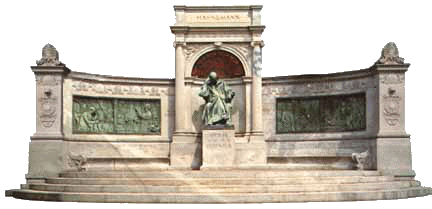
Monument to Dr. C.F. Samuel Hahnemann, Scott Circle, Washington, D. C. erected by the American Institute of Homeopathy and dedicated and presented to the U. S. Government on June 21, 1900. Sculptor, C. H. Niehaus. Architect, J. F. Harder.
This report was taken from James Stephenson, M.D.'s REVIEW OF INVESTIGATIONS INTO THE ACTION OF SUBSTANCES IN DILUTIONS GREATER THAN 1 X 10 -24 (MICRODILUTIONS) from the Journal of the American Institute of Homeopathy, November, 1955, Vol. 48, No. 11, pp. 327-335
Monument to Dr. C.F. Samuel Hahnemann, Scott Circle, Washington, D. C. erected by the American Institute of Homeopathy and dedicated and presented to the U. S. Government on June 21, 1900. Sculptor, C. H. Niehaus. Architect, J. F. Harder.
In 1951 Alphonse Gay demonstrated that microdilutions
have dielectric indices which differ from their liquid vehicles and are
specific both for the substances in dilution as well as for the degree
of dilution. His apparatus consisted of "a type of capacitance, a mercury
armature and a dielectric easily interchangeable . . . introduced in circuit
with a galvanometer."
The changes in capacitance of the various
microdilutions were recorded as fluctuations of the galvanometer from zero.
He obtained sinusoidal curves for microdilutions ranging up to 10 to the
60th power of Strychnos nux vomica, Pulsatilla nigricans, Lycopodium
clavatum, Cinchona officinalis, Ignatia amara, Castoreum, Moschus,
sodium chloride and Sepia officinalis.
In 1952 Gay and Boiron reported the result
of a series of exhaustive investigations into the action of microdilutions
. In a comparison between the capacitance of distilled water and sodium
chloride, carried through identical stages of dilution to 10 to the sixtieth
power, both dilutions gave sinusoidal curves which approximated each other
fairly closely except that at 10 to the 26th, 38th and 54th power they
were in direct opposition.
In addition they found that "Ohms law is not
applicable for microdilutions . . . that the electrical resistance is not
linear for frequencies between 1.050 and 2.650 periods per second."
In 1953 Gay extended his work in collaboration
with Jean Boiron. Using the same apparatus, in 100 out
of 100 attempts they were able to distinguish a flask containing
sodium chloride, diluted out 10 to the 54th power, (which
by my reckoning is the same as 27c and is well beyond Avogadro's limit
-j.b.) from six other identical flasks containing distilled water.
John R. Benneth
gian@cyberhighway.net